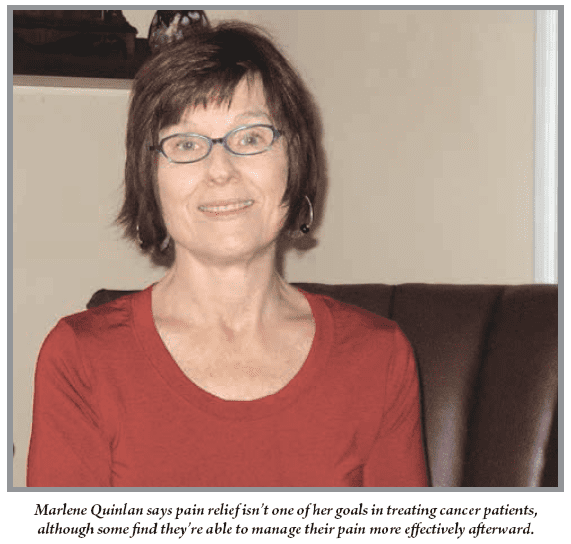Mind Over Matter – Hypnosis Can Benefit a Wide Variety of People
Many people have a distorted idea of what hypnosis is, thinking it involves loss of control or, worse yet, mind control by the practitioner. In reality, say practitioners of hypnosis in a medical setting, subjects are always conscious and never do anything they don’t want to do. Rather, the process helps patients — from expectant mothers to cancer patients to people facing surgery — find a place of relaxation inside them that they can return to again and again, forging a strong connection between mind and body that promotes peace and healing.
Hypnosis, Marlene Quinlan says, is not a loss of consciousness, or a ceding of free will. And it’s not a party trick.
“I always make sure people I’m working with understand that I am their guide,” said Quinlan, an oncology social worker at the D’Amour Center for Cancer Care in Springfield, who uses hypnosis with some patients who are struggling with anxiety and other aspects of a cancer diagnosis. “I’m not doing anything to them; they’re allowing themselves to enter this hypnotic trance state. It’s a skill they actually have inside them. My goal is to help them do that on their own.”
Some patients begin the process with skepticism, she added, spurred partly by distorted perceptions about hypnosis from the entertainment world. “I always explain what hypnosis is and what it isn’t. It won’t make you undress or cluck like a chicken … unless, of course, you want to cluck like a chicken.”
In short, it’s not a loss of control, she explained. Quite the opposite, hypnosis done for the right reasons is empowering. “Basically, people feel like they possess a tool inside of them that allows them to feel like they can deal with the stress in their life. People are most stressed when they feel like there’s nothing they can do about their situation; they want a tool like this to manage their stress.”
Ann Buscemi, a certified hypnotherapist and educator who spends part of her time working with patients at Cooley Dickinson Hospital, conducts a program there for pregnant women called Deep Relaxation for Pregnancy, Birth, and Beyond.
“It’s not centered on the outcome being a guaranteed, non-medicated birth, but focuses on confidence and feeling comfortable and calm, regardless of what comes your way in birth, because birth is always unique and different,” she told HCN.
“What I’ve found, from many, many years working with pregnant women, is that, if I can help them find a quiet space within, and allow their body to do the work in knows how to do, everyone will be in a better place; it’s better for the woman, better for the partner, and better for the baby.”
Women in the program learn to enter a hypnotic state in order to relax and regulate their breathing, but the process is also beneficial for women preparing for a scheduled cesarean birth, she said, to deal with the anxiety of what is, in fact, major surgery.
“We really focus on the relaxation piece,” said Buscemi, who also teaches a class for nurse midwives on \ the basics of childbirth education. “The feedback I get from the midwifery center is that it really makes a difference.”
For this month’s focus on alternative health, HCN explores what hypnosis in a medical setting involves, and why many patients grappling with fear, anxiety, pain, and other issues find the process liberating — and healing.
Free Your Mind
Buscemi, like Quinlan, emphasizes the free-will element of hypnosis, reiterating that it’s most effective on individuals who are open to it and understand what it is.
“A lot of people fear it because, so often, we hear about a guy at the Hu Ke Lau bringing people up on stage, and they start quacking like a duck. If someone wants that to happen, it will happen; it’s not mind control. You can’t make somebody do anything against who they are, religiously or ethically.” So, how does hypnosis work?
“It’s getting to that subconscious space where I can plant a seed for positive results,” Buscemi explained. “It’s sort of moving beyond your fears and anxiety and introducing positive words, positive images, deep relaxation, lower blood pressure, and, again, better outcomes.
Much of the success of hypnosis is improved confidence and attitude, she explained, adding that each individual experiences the specifics differently. For example, in learning to breathe during labor, “you can think of your breath in any way you wish. Some women see their breath as fueling their body, so their body can do the work. Other women see it as a parachute above their body; they see it as a means of staying outside their body and therefore not getting in the way. … I never say, ‘you must do it this way.’”
Buscemi said she tries to bring a sense of humor to the process as well, again, to decrease the tension of impending childbirth. “Having a baby can be incredibly scary for people, and I try to help them find that quiet space.”
As an oncology social worker, Quinlan’s job entails a number of functions. “Hypnosis is a small part of what I do on a regular basis,” she said, “and not every patient I work with would necessarily want to think about hypnosis as something helpful to them. For those who are interested, I would discuss it with them as an option in the bigger picture of helping them cope with cancer.
“There are, for sure, situations that come up where I have been able to use hypnosis,” she added. “Essentially, the first step is working with the patient to establish what their goals are. I’m very goal-oriented.”
In addition to helping them reduce anxiety, Quinlan has worked with cancer patients on smoking cessation obviously, an important factor in helping the body fight off the disease. But, she said, there first needs to be a deeply felt desire to make that life change — or any change for which hypnosis might help.
“Hypnosis won’t make you do anything you don’t want to do,” Quinlan said. “That’s why it’s important, when doing an assessment, to find out what their goals really are, if it’s what they
really want. If I receive a referral to help someone quit smoking, and during my assessment, I hear them saying, in so many words, that they’re not really interested in quitting, that can be an obstacle.”
Therefore, some patients need more conventional counseling first to get to the bottom of what they really want, or to assure themselves that they really want what hypnosis could help them achieve.
“It’s not a magic pill,” she told HCN. “And one session of hypnosis isn’t going to cure all your ills, although many people think of it that way.” In fact, sometimes the first session doesn’t involve hypnosis at all, but is a thorough assessment of the patient’s mindset and goals.
The Rest Will Follow
Buscemi also conducts hypnotherapy for cancer patients, through the Cancer Connection in Northampton.
“It’s really taking time with people who are looking at surgery or chemotherapy or radiation therapy, and focusing on healing,” she explained. “It’s really challenging to be faced with a diagnosis — a life threatening diagnosis and then everything you have to do to get through it.
“I’ve found, in working with people at the Cancer Connection, that they haven’t thought about being OK,” she continued. “I help them come up with visualization and focus, seeing themselves as healed, helping them through their fear, anxiety, and stress, using the things going on around them and within them to help them promote more relaxation.”
While different patients call for different techniques, Buscemi said she often uses a “color healing” form of visualization, where chemotherapy patients picture the liquids going into their bodies as a healing color. Similarly, “I’ve written a script about powerful beams of light for working with a man with prostate cancer.”
Every case is different, she said. “I take the time to find out what they love. Do they love the beach? Then let’s use [images of] waves, waves of healing. You have to make it something they can relate to, never something I think they should be thinking about. I think that’s important; I don’t know what’s going to work for people, so it’s a discovery time for me.”
Buscemi also creates a CD that patients can use at home — before, during, or after their treatments — to practice self-hypnosis as an ongoing tool. “That’s important, that they have this tool to listen to anytime,” she said. “I’m not just planting a seed, but really pressing it in and making sure it’s wellsown in their mind.”
Anytime a patient can relax whether it’s a woman giving birth, a patient prepping for surgery, or someone sitting in a dentist’s chair — it makes life easier for everyone, including the care provider, Buscemi said. And often, when hypnosis is conducted in conjunction with serious procedures, “you need less anesthesia, you leave the hospital earlier, you need less pain medication. That mind-body piece is significant, and it makes a difference.”
The concept of seeking hypnosis before a surgical procedure has been promoted by Massachusetts psychotherapist Peggy Huddleston, who offers a course to healthcare providers called “Prepare for Surgery, Heal Faster.”
Huddleston’s process involves using visualization to turn surgery worries into positive, healing imagery; listening to her relaxation CD or mp3; asking family and friends to wrap the patient in a “blanket of love” before surgery; and using “healing statements” during and after surgery that, she claims, reduce the need for pain medication in most patients.
“You’re planting a suggestion that the surgery will go well, and recovery will go well,” Quinlan said. “Entering that procedure feeling really positive about the outcome can help you.”
Hypnosis can also help them with ancillary stressors for cancer patients, she added. “Some people have difficulty sleeping, and cancer does create anxiety, which causes difficulty sleeping. If I can teach them how to relax and go into a trance state at bedtime, they’ll sleep better” — and, in circular fashion, reduce the stress that caused the sleeplessness to begin with.
Peace of the Action
Some hypnotherapists use the process for pain relief, but Quinlan is careful with how she frames that idea.
“I never say to somebody, ‘if you see me and we do hypnosis, it will help you with your pain,’” she told HCN. “But a couple of my patients have had pain issues, and they’ve actually been able, as a side effect of hypnosis, to feel like their pain has improved. I think they’re able to relax, and there’s less tension in their bodies, and therefore they’ve felt some relief from their pain, but I don’t promote that as a substitute for whatever pain management is being promoted by their doctors.”
She also stressed that hypnosis is not a cure-all, and is generally undertaken in tandem with other treatment modalities.
“Often, in conjunction with hypnosis, we’re also doing counseling around what they’re thinking and feeling, and somehow, the combination of these things helps them reframe their thoughts on the situation.
“If you’re focusing on your fears,” she added, “you’re going to have anxiety. But if you’re finding a way to distract yourself and not always be focused on your fears, and having some mastery over your stress, I think I can help you get into a better place emotionally.”
Buscemi says her work is gratifying on a number of levels.
“I know this works; I know it makes a difference,” she said, but she’s still thrilled when patients tell her the process has helped them in some way, and honored that she can be a part of helping them through events both happy the birth of a child — and traumatic, like cancer.
“That’s a gift to me,” she said. “It reminds me how precious life is.”






Comments are closed.